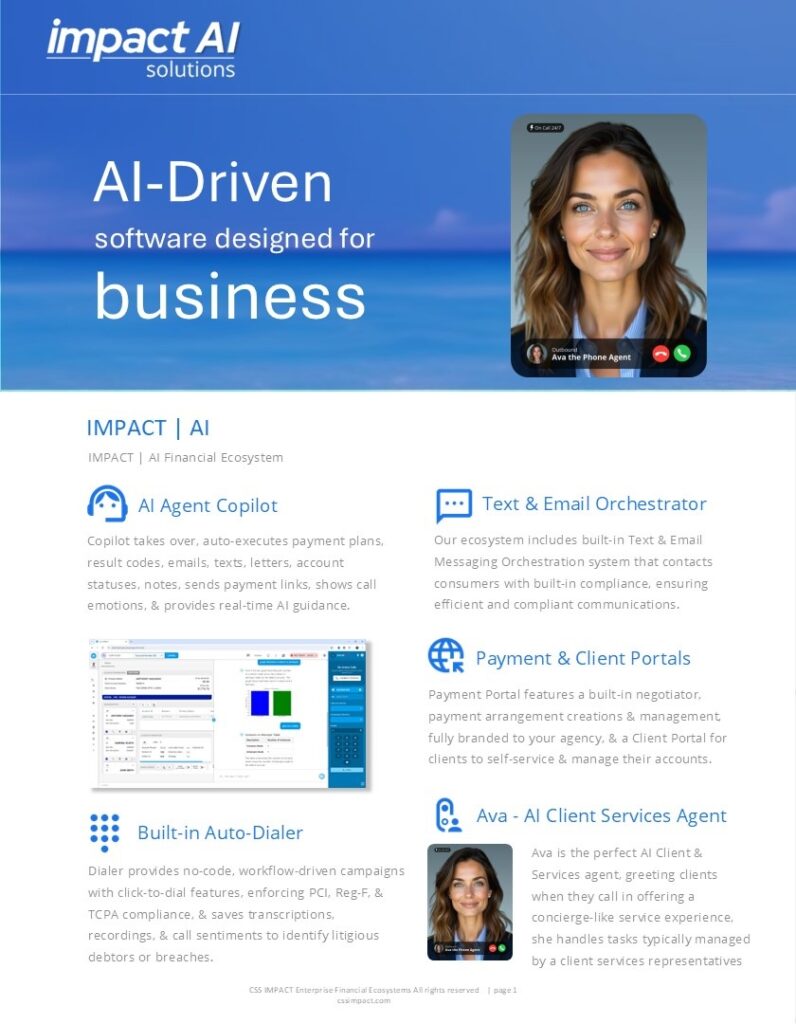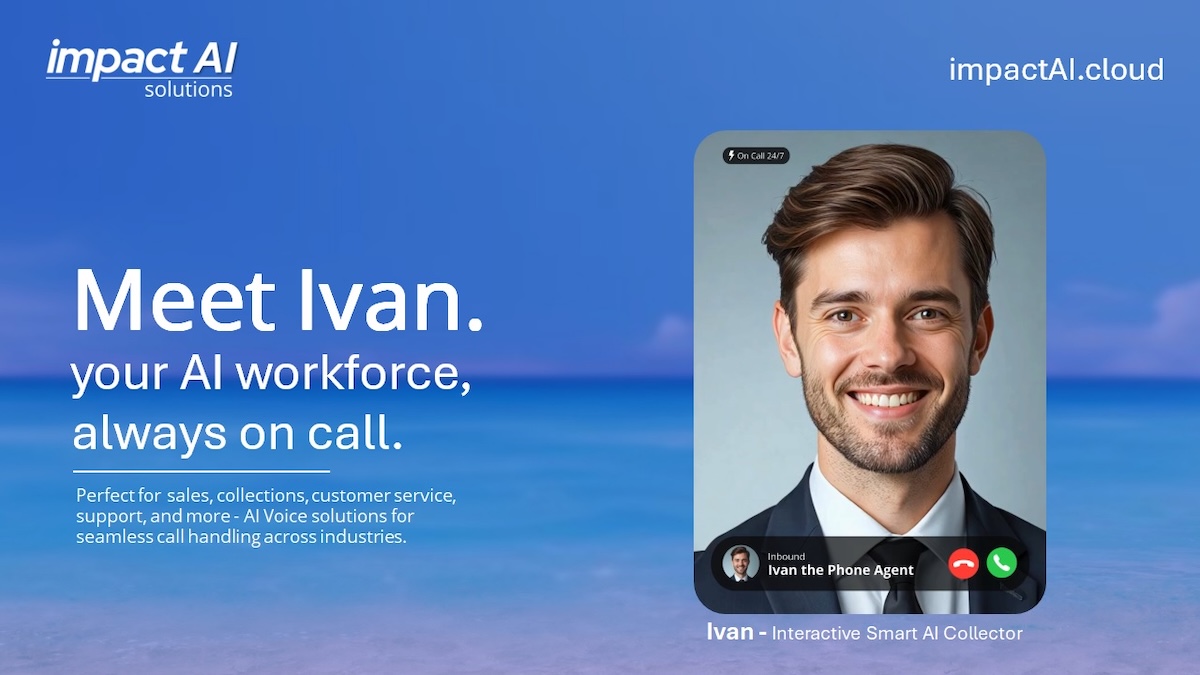CSS Impact has spent the last two decades evolving and expanding its operations based on emerging technology with a drive toward efficiency.
The latest move in this push is the launch of its AI-powered debt collectors: Ava and Ivan.
The Woodland Hills-based company covers a lot of ground in the financial services industry as an all-in-one “ecosystem that carries every periphery of technology for engagement and the management of that engagement” spanning originations, loan servicing, accounts receivables management, collections, legal, compliance and portfolio management across industries, Carl Briganti, president and chief executive at CSS, said.
Briganti sees particular traction with Ava and Ivan in the collection and customer service contact center spaces because they are available 24/7, allowing consumers to handle these tasks on their own time frame, and they can communicate in over 40 languages. Additionally, Briganti suggested people may feel less pressure speaking to an AI agent versus a real person, allowing them to ask more questions or ask questions in various forms to dismantle any uncertainties.
The Ava and Ivan duo cover separate areas with Ava’s primary focus being inbound client services. Ava can answer questions, produce documents, send call transcripts and more for collection agencies and their clients, such as hospitals and banks, inquiring about particular accounts.
Meanwhile, Ivan works with debtors both inbound and outbound to resolve debt, provide billing information and negotiate payments.
Sandeep Krishnamurthy, dean of Cal Poly Pomona’s College of Business Administration and Singelyn Graduate School of Business, said the addition of Ava and Ivan represents a larger shift in the world of AI from “productivity to process.”
Before Ava and Ivan, CSS Impact’s AI function in debt collection acted like a co-pilot to human agents, making recommendations and generating information for human collectors, as well as providing sentiment analysis to suggest the most effective ways to communicate with someone based on their apparent mood. To Krishnamurthy, this is productivity, while Ava and Ivan represent process.
“Getting (AI’s) assistance to improve the productivity of human agents was the first emphasis where we saw the business opportunities of generative AI,” Krishnamurthy said. “Now what we are seeing is … AI acting as an agent to get the personalized information of the customer and then take over some parts of the process where the AI will interface with the customer.”
Best practices for effectiveness
Ava and Ivan have been programmed to evaluate someone’s mood and emotional state which informs their responses accordingly during service calls.
“The AI agent is very human-like … and extremely empathetic, but it never breaks role – that’s the wonderful part about it,” Briganti said. “It’s agile enough to concede to an answer that maybe is not part of that conversation or the intent of that service, but it can shepherd the patient or the consumer or the debtor straight into either answering any questions, negotiating some form of payment or assisting them on a resolution.”

When determining best practices for these agents, Krishnamurthy said it boils down to accuracy, timeliness and demeanor.
Those first two points are largely safeguarded by the AI agents’ embedded regulatory compliance and their immediate access to the specific account data and information for whichever account they are working on in that given moment. It’s worth noting that this is the only information they have on hand, as they do not have access to internet searching or other accounts they have worked on previously, Briganti explained.
“Even if a consumer, a debtor, a patient comes in and says, ‘Give me the capital of Colombia,’ it’ll say, ‘…I’m an AI agent just to assist you for these purposes,’” Briganti said.
Additionally, CSS Impact has more than 20 security certifications including from the U.S. government’s Federal Risk and Authorization Management Program.
Moving to demeanor, Krishnamurthy pointed out AI’s “subservient” nature and its ability to be trained to respond with empathy – though specificity is key, especially when dealing with debt collection where the goal is payment. For example, programming the agent to be respectful, friendly and warm but also firm could strike the right balance, he said.
AI’s unwavering obedience to its own programming can also eliminate human error in terms of precision but also emotional variance.
In fact, Krishnamurthy points to research detailing that humans often prefer interacting with technology over humans in general for reasons of accuracy, efficiency and the feeling of a judgment free interaction.
In addition to possible benefits on the debtor side, the AI agents could potentially improve collection employees’ day-to-day experience.
“People hate debt collectors because they call at the wrong time and they bring up uncomfortable truths,” Krishnamurthy said. “People find them annoying and irritating and so I think it is good for the sanity of the employees to have AI step in a little bit and at least help with the long-term morale of the employees.”
Even still, Krishnamurthy emphasized keeping the “human in the loop” throughout these processes, opting for human and AI collaboration.
“The idea is that it is not just the escalation of the technical capabilities of AI,” Krishnamurthy said. “It is how we as human beings will work with AI to achieve our goals.”
To that end, Ava and Ivan can automatically move certain situations up the chain of command if they are beyond their range of capabilities. One example Briganti gave was if a caller explained they could not make a payment due to impacts of the recent wildfires.
“(The AI agent could then say), ‘It looks like you’re in an area where you need assistance. We’re going to forward this account to our assistance team, and we’re going to make sure that our next communication is simply to assist you in your situation,’” Briganti said. From there, the agent can transfer the call’s recording, transcript and sentiment analysis through a processed workflow to that assistance team.
Lenses, results and client growth
While more time will be needed to tell the effectiveness of Ava and Ivan, CSS Impact’s previous AI initiatives have proven favorable in both attracting clients and producing results for those clients.
Zooming out from its debt collection-specific services, CSS Impact has implemented AI overlays across its entire platform of financial services for three main functions: compliance, psychology of consumer engagement, and revenue and control cost management.
“We focus on every possible iteration of a cost that is tangible and trackable within an organization,” Briganti said with regard to revenue and control cost management.
This means having AI modules calculate employees’ hourly rates, how much time they spend on various tasks for particular accounts and how much revenue those efforts generate for the company, even taking into consideration how much office space square footage someone is occupying and its cost on the company.
“We balance (the ultimate revenues) against the cost, giving the enterprise the ability to identify their true net gains or their net revenue, and this is all done in real time,” Briganti said. “(From there), management and financial officers can actually have real-time conversations so they can control costs.”

Through internal case studies of its clients, CSS Impact has found companies who use its platform see a $10 million revenue increase in the first year with sustained annual growth of $125 million to $130 million.
About five years ago, when CSS Impact pivoted from a set of platforms to its an all-in-one ecosystem, Briganti said the company saw large-scale growth with a surge in big name customers, particularly in the government sector. San Francisco, Santa Clara County, the state of Utah, Pittsburgh, Cincinnati and Miami-Dade County are a few examples. San Francisco in particular increased its revenue by $100 million in its first year working with CSS.
“A bunch of municipalities have onboarded with us because we offer the ecosystem,” Briganti said. “Most other technologies are disparate platforms, which are great, but they become brittle when having to integrate with separate payment portals, separate AI solutions, separate digital and voice engagement offerings.”
Thus, an all-in-one platform is easier for companies to manage and faster to deploy, he added, noting that it also mitigates potential conflicts with numerous external vendors.
Krishnamurthy echoed the ability of this model to cut costs for companies.
“A lot of companies are not able to leverage all the information that they have because it is in a format that is not accessible or it might be in multiple systems and databases,” Krishnamurthy said. “Now suddenly you have systems that are allowing you to go through all of this and understand what you’re facing much better.”